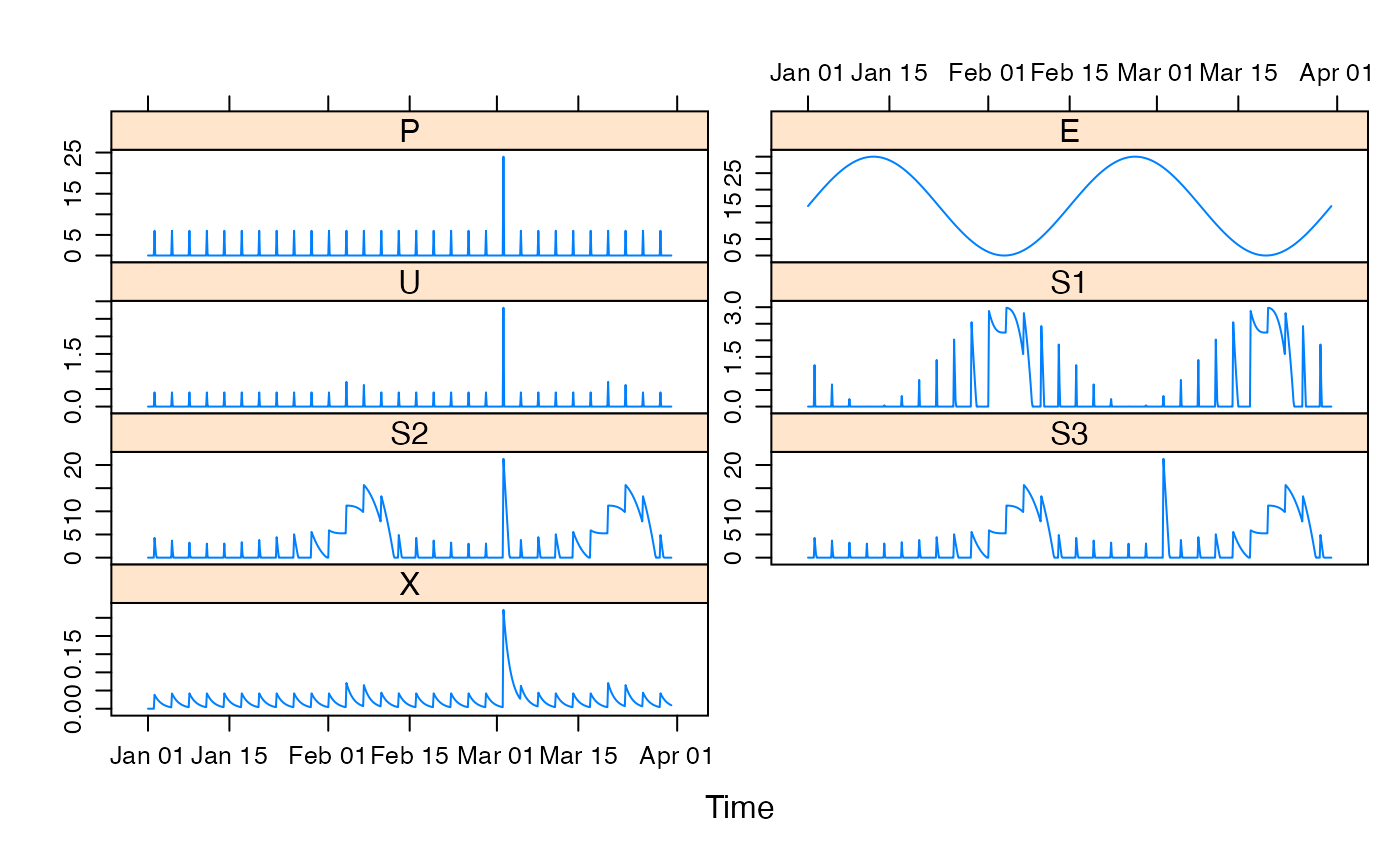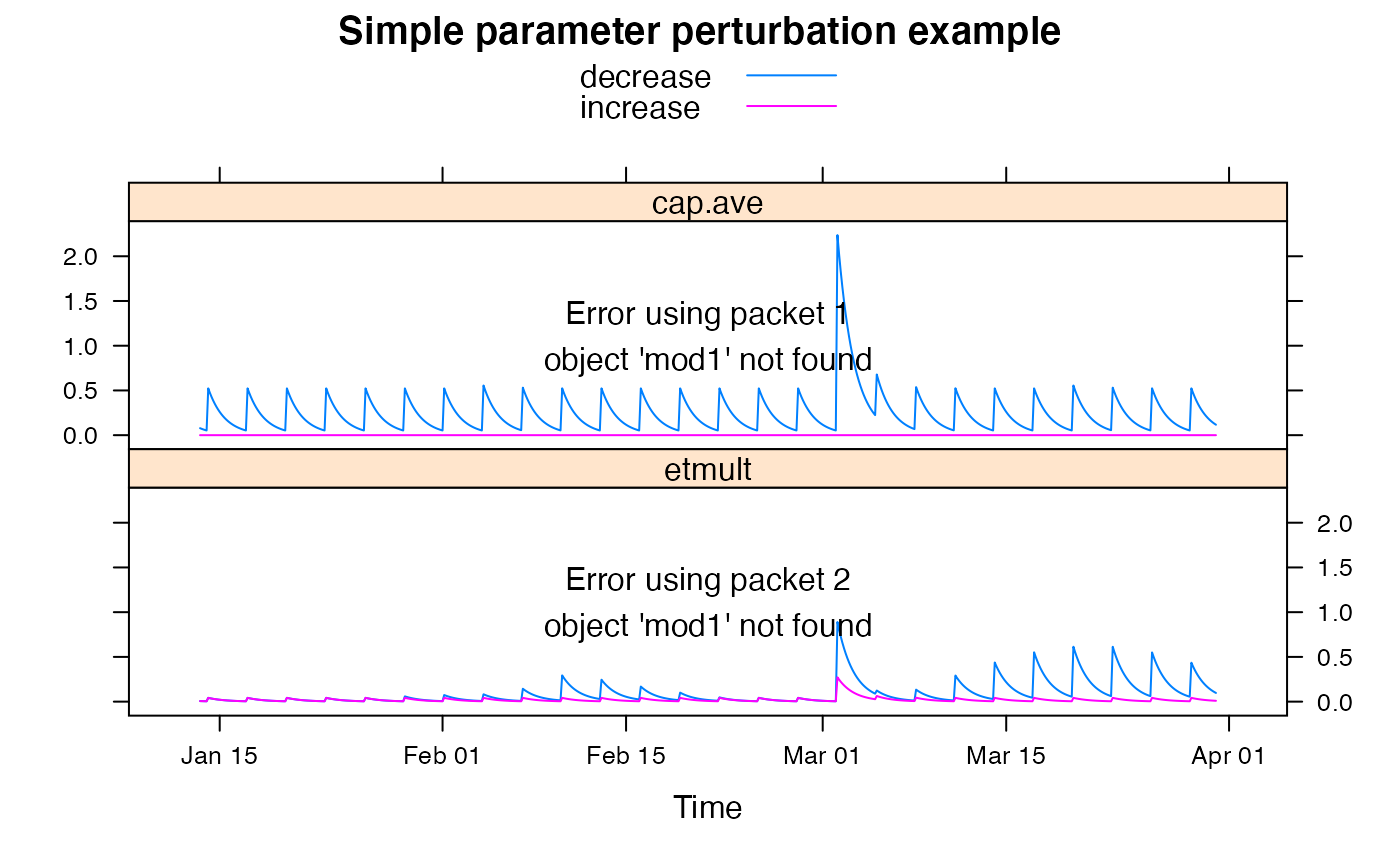Australian Water Balance Model (AWBM): simple 3 bucket model.
awbm.sim(
DATA,
cap.ave,
cap1 = 0.01 * cap.ave/area1,
cap2 = 0.33 * cap.ave/area2,
cap3 = 0.66 * cap.ave/area3,
area2 = 0.433,
area3 = 0.433,
area1 = 1 - area2 - area3,
etmult = 1,
S1_0 = 0,
S2_0 = 0,
S3_0 = 0,
return_state = FALSE
)Arguments
- DATA
time-series-like object with columns P (precipitation, mm) and E (potential evapo-transpiration, mm).
- cap.ave
average soil water storage capacity (mm). This is not used directly in the model, but rather to define default values of the other parameters.
- cap1, cap2, cap3
soil water storage capacities (mm) for the three fractional areas.
- area1, area2, area3
fractional areas with corresponding capacities. These must sum to 1.
- etmult
multiplier for the
Einput data.- S1_0, S2_0, S3_0
initial soil moisture levels (mm).
- return_state
to return the soil moisture levels
S1,S2andS3together with effective rainfallU.
Value
the simulated effective rainfall, a time series of the same length as the input series.
Details
This is a very simple model: saturation excess from three buckets with different capacities are added together with fractional areas for weights.
This is the soil moisture accounting component; the model described in the
literature has a two-store routing component also, with parameters
BFI, \(K_b\) and \(K_s\). These correspond directly to the
expuh routing model parameters v_s, tau_s and
tau_q, so the full model can be specified as:
hydromad(..., sma = "awbm", routing = "expuh", rfit = list("sriv",
order = c(2, 1)))
References
Boughton, W. (2004). The australian water balance model. Environmental Modelling & Software 19 (10), 943-956. http://dx.doi.org/10.1016/j.envsoft.2003.10.007
See also
hydromad(sma = "awbm") to work with models as objects
(recommended).
Examples
## view default parameter ranges:
str(hydromad.options("awbm"))
#> List of 1
#> $ awbm:List of 2
#> ..$ cap.ave: num [1:2] 1 1000
#> ..$ etmult : num [1:2] 0.01 1
data(HydroTestData)
mod0 <- hydromad(HydroTestData, sma = "awbm", routing = "expuh")
mod0
#>
#> Hydromad model with "awbm" SMA and "expuh" routing:
#> Start = 2000-01-01, End = 2000-03-31
#>
#> SMA Parameters:
#> lower upper
#> cap.ave 1.00 1000
#> etmult 0.01 1
#> Routing Parameters:
#> NULL
## simulate with some arbitrary parameter values
mod1 <- update(mod0, cap.ave = 40, etmult = 0.1, tau_s = 10)
## plot results with state variables
testQ <- predict(mod1, return_state = TRUE)
xyplot(cbind(HydroTestData[, 1:2], awbm = testQ))
 ## show effect of increase/decrease in each parameter
parRanges <- list(cap.ave = c(1, 1000), etmult = c(0.01, 1))
parsims <- mapply(
val = parRanges, nm = names(parRanges),
FUN = function(val, nm) {
lopar <- min(val)
hipar <- max(val)
names(lopar) <- names(hipar) <- nm
fitted(runlist(
decrease = update(mod1, newpars = lopar),
increase = update(mod1, newpars = hipar)
))
}, SIMPLIFY = FALSE
)
xyplot.list(parsims,
superpose = TRUE, layout = c(1, NA),
main = "Simple parameter perturbation example"
) +
latticeExtra::layer(panel.lines(fitted(mod1), col = "grey", lwd = 2))
## show effect of increase/decrease in each parameter
parRanges <- list(cap.ave = c(1, 1000), etmult = c(0.01, 1))
parsims <- mapply(
val = parRanges, nm = names(parRanges),
FUN = function(val, nm) {
lopar <- min(val)
hipar <- max(val)
names(lopar) <- names(hipar) <- nm
fitted(runlist(
decrease = update(mod1, newpars = lopar),
increase = update(mod1, newpars = hipar)
))
}, SIMPLIFY = FALSE
)
xyplot.list(parsims,
superpose = TRUE, layout = c(1, NA),
main = "Simple parameter perturbation example"
) +
latticeExtra::layer(panel.lines(fitted(mod1), col = "grey", lwd = 2))
